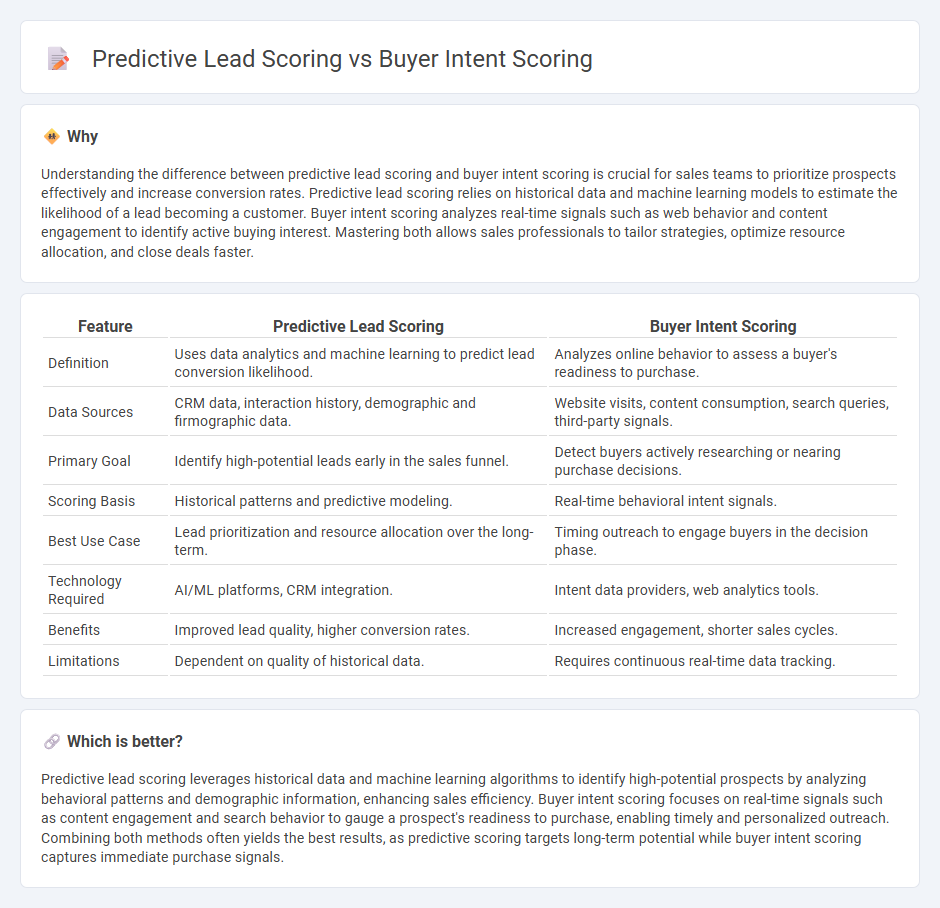
Predictive lead scoring uses historical data and machine learning to prioritize prospects based on their likelihood to convert, while buyer intent scoring analyzes real-time behavioral signals indicating a prospect's current interest in specific products or services. Both methods enhance sales efficiency by focusing efforts on high-potential leads, reducing time wasted on less promising contacts. Explore how integrating these scoring models can amplify your sales strategy and drive higher close rates.
Why it is important
Understanding the difference between predictive lead scoring and buyer intent scoring is crucial for sales teams to prioritize prospects effectively and increase conversion rates. Predictive lead scoring relies on historical data and machine learning models to estimate the likelihood of a lead becoming a customer. Buyer intent scoring analyzes real-time signals such as web behavior and content engagement to identify active buying interest. Mastering both allows sales professionals to tailor strategies, optimize resource allocation, and close deals faster.
Comparison Table
| Feature | Predictive Lead Scoring | Buyer Intent Scoring |
|---|---|---|
| Definition | Uses data analytics and machine learning to predict lead conversion likelihood. | Analyzes online behavior to assess a buyer's readiness to purchase. |
| Data Sources | CRM data, interaction history, demographic and firmographic data. | Website visits, content consumption, search queries, third-party signals. |
| Primary Goal | Identify high-potential leads early in the sales funnel. | Detect buyers actively researching or nearing purchase decisions. |
| Scoring Basis | Historical patterns and predictive modeling. | Real-time behavioral intent signals. |
| Best Use Case | Lead prioritization and resource allocation over the long-term. | Timing outreach to engage buyers in the decision phase. |
| Technology Required | AI/ML platforms, CRM integration. | Intent data providers, web analytics tools. |
| Benefits | Improved lead quality, higher conversion rates. | Increased engagement, shorter sales cycles. |
| Limitations | Dependent on quality of historical data. | Requires continuous real-time data tracking. |
Which is better?
Predictive lead scoring leverages historical data and machine learning algorithms to identify high-potential prospects by analyzing behavioral patterns and demographic information, enhancing sales efficiency. Buyer intent scoring focuses on real-time signals such as content engagement and search behavior to gauge a prospect's readiness to purchase, enabling timely and personalized outreach. Combining both methods often yields the best results, as predictive scoring targets long-term potential while buyer intent scoring captures immediate purchase signals.
Connection
Predictive lead scoring and buyer intent scoring both analyze data to prioritize sales leads based on their likelihood to convert. Predictive lead scoring uses historical data and machine learning models to assign scores, while buyer intent scoring focuses on analyzing behavioral signals indicating a prospect's readiness to purchase. Integrating these methods enhances sales efficiency by targeting high-propensity leads with timely, personalized outreach.
Key Terms
Purchase Signals (Buyer Intent Scoring)
Buyer intent scoring analyzes real-time purchase signals such as web behavior, content engagement, and keyword searches to identify prospects with a high likelihood of buying. Predictive lead scoring uses historical data and machine learning models to rank leads based on their probability of conversion over time. Explore detailed differences and applications to optimize your sales funnel effectively.
Predictive Analytics (Predictive Lead Scoring)
Predictive lead scoring uses machine learning algorithms to analyze historical customer data and identify patterns that indicate high-quality leads most likely to convert. This approach integrates multiple data points such as demographic information, website interactions, and past purchase behavior to generate an accurate and dynamic lead score, enhancing sales efficiency and targeting precision. Discover how predictive analytics can transform your lead management strategy and boost conversion rates.
Data Sources
Buyer intent scoring leverages real-time behavioral data from website interactions, content consumption, and third-party intent signals to gauge a prospect's readiness to purchase. Predictive lead scoring uses historical CRM data, demographic information, and past sales outcomes to forecast conversion likelihood based on patterns and trends. Explore how integrating diverse data sources enhances targeting accuracy and improves sales performance.
Source and External Links
Buying Intent Overview - Apollo - Buyer intent scoring quantifies a company's likelihood to buy using metrics such as frequency, trend, and recency of intent signals, with scores categorized as low, mid, or high based on data from providers like Bombora and LeadSift.
Buyer Intent Explained: Why It Matters & How To Use It - Demandbase - Buyer intent scoring identifies prospects' readiness and likelihood to purchase by analyzing behavioral data and engagement patterns to optimize targeting and sales efforts, moving beyond traditional lead scoring to focus on timing and intent.
Outreach Buyer Intent Score FAQs - The Buyer Intent Score in Outreach is a numeric field used to prioritize accounts most likely to become customers, allowing sorting and filtering to focus sales efforts on high-intent prospects through integrations with third-party data.
 dowidth.com
dowidth.com